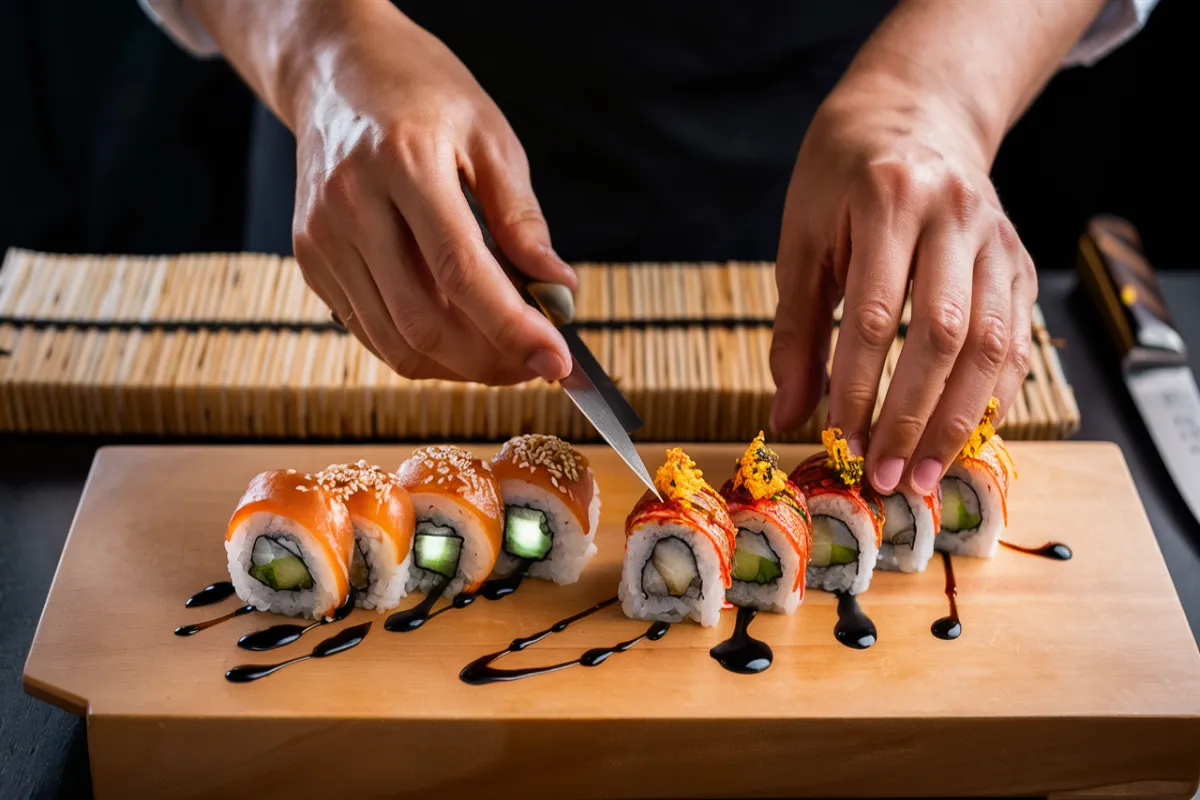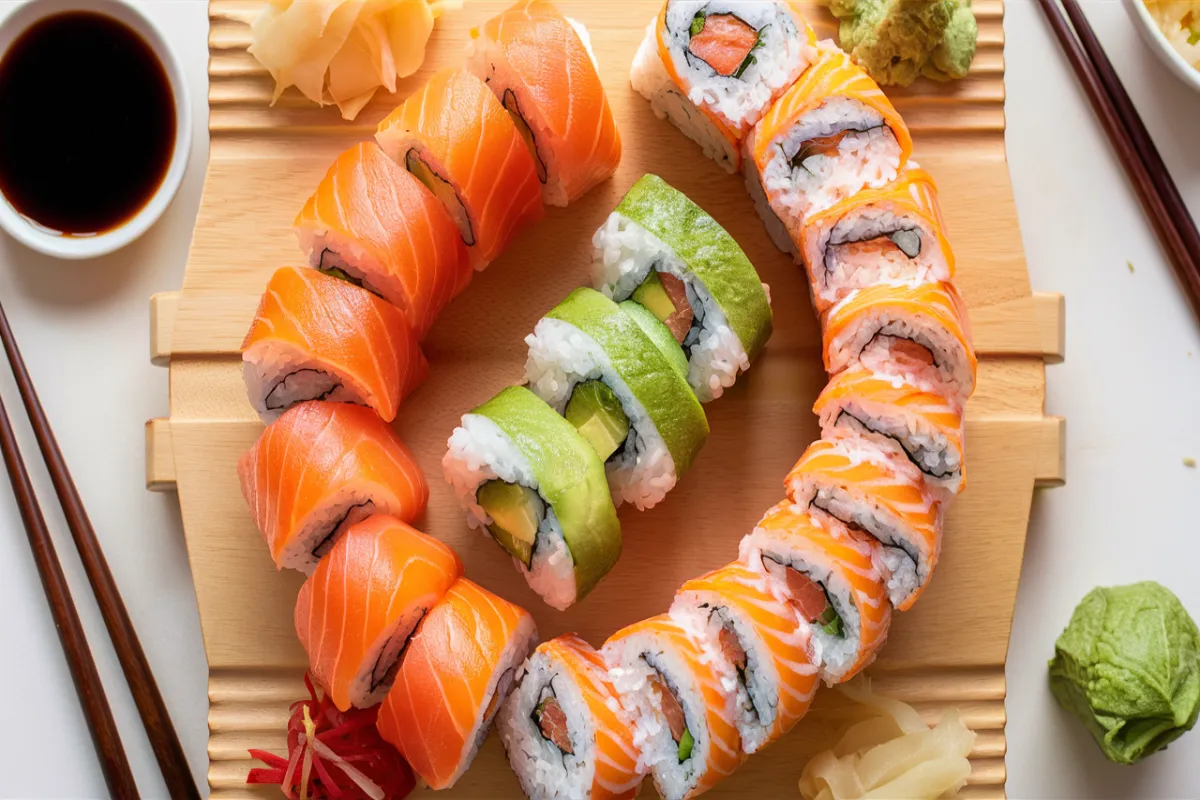When exploring sushi menus, you might wonder, “What is the difference between a Philadelphia roll and an Alaska roll?” Both rolls feature delicious combinations of fresh ingredients, yet they offer distinct flavors and textures. Understanding these differences helps you choose the right roll for your palate. In this comprehensive guide, I will break down the key differences between a Philadelphia roll and an Alaska roll, focusing on their ingredients, flavors, textures, and presentation.
1. Overview of the Philadelphia Roll
1.1 Key Ingredients in a Philadelphia Roll
The Philadelphia roll features a unique combination of smoked salmon, cream cheese, and cucumber. This roll typically includes nori (seaweed) and sushi rice as the base. The smoked salmon adds a rich, smoky flavor, while the cream cheese provides a creamy texture. The cucumber contributes a refreshing crunch, balancing the richness of the other ingredients. Because of its distinct flavor profile, the Philadelphia roll stands out among other sushi rolls.
1.2 Flavor Profile of a Philadelphia Roll
The Philadelphia roll offers a blend of rich, smoky, and creamy flavors. The smoked salmon brings a savory depth, while the cream cheese adds a smooth, tangy taste. The cucumber’s crispness balances these flavors, preventing the roll from becoming too heavy. This combination creates a well-rounded sushi roll that appeals to those who enjoy bold, contrasting flavors.
1.3 Texture of a Philadelphia Roll
The texture of a Philadelphia roll is a key part of its appeal. The smoked salmon provides a tender, slightly chewy texture, while the cream cheese is soft and smooth. The cucumber adds a crunchy contrast, ensuring that each bite offers a satisfying mix of textures. This variety in texture enhances the overall eating experience, making the Philadelphia roll a favorite for many sushi lovers.
1.4 Presentation of a Philadelphia Roll
Philadelphia rolls are often presented with the smoked salmon visible on top, giving the roll a vibrant orange color. The roll may be garnished with a drizzle of soy sauce or a sprinkle of sesame seeds. The presentation is simple yet elegant, highlighting the key ingredients. Therefore, the Philadelphia roll’s presentation reflects its straightforward, yet flavorful, composition.
2. Overview of the Alaska Roll
2.1 Key Ingredients in an Alaska Roll
The Alaska roll features fresh salmon, avocado, and cucumber. Like the Philadelphia roll, it also uses nori and sushi rice as the base. Fresh salmon adds a delicate, buttery flavor, while avocado contributes a creamy richness. The cucumber, as in the Philadelphia roll, provides a crisp texture. These ingredients work together to create a light, refreshing sushi roll that highlights the natural flavors of its components.
2.2 Flavor Profile of an Alaska Roll
The Alaska roll offers a milder flavor compared to the Philadelphia roll. The fresh salmon brings a subtle, buttery taste, while the avocado adds a gentle creaminess. The cucumber’s crispness enhances these flavors, making the roll light and refreshing. This combination appeals to those who prefer a more delicate flavor profile in their sushi.
2.3 Texture of an Alaska Roll
The texture of an Alaska roll is smooth and refreshing. The fresh salmon provides a soft, tender bite, while the avocado adds a creamy, buttery texture. The cucumber’s crunch contrasts with these softer elements, adding a refreshing note to each bite. This blend of textures makes the Alaska roll a delightfully light and satisfying option.
2.4 Presentation of an Alaska Roll
Alaska rolls are typically presented with the fresh salmon either on top or inside the roll. The roll may be garnished with tobiko (fish roe) or a drizzle of soy sauce. The presentation often emphasizes the fresh, vibrant colors of the ingredients, particularly the bright orange salmon and the green avocado. Therefore, the Alaska roll’s presentation reflects its fresh, light composition.
3. Comparing Ingredients: Philadelphia Roll vs. Alaska Roll
3.1 Salmon: Smoked vs. Fresh
One of the main differences between the Philadelphia roll and the Alaska roll lies in the type of salmon used. The Philadelphia roll uses smoked salmon, which adds a rich, smoky flavor and a slightly firmer texture. In contrast, the Alaska roll features fresh salmon, offering a more delicate, buttery flavor and a softer texture. This difference in salmon gives each roll a distinct taste and mouthfeel.
3.2 The Role of Cream Cheese
The Philadelphia roll includes cream cheese, which adds a creamy, tangy element to the roll. This ingredient is absent in the Alaska roll, which instead relies on avocado for its creamy texture. The cream cheese in the Philadelphia roll creates a richer, heavier flavor, while the avocado in the Alaska roll offers a lighter, more refreshing taste. This difference in ingredients significantly impacts the flavor profile of each roll.
3.3 Cucumber: A Shared Ingredient
Both the Philadelphia roll and the Alaska roll include cucumber as a key ingredient. The cucumber provides a crisp, refreshing crunch in both rolls, balancing the richer ingredients like smoked salmon, cream cheese, or avocado. While cucumber plays a supporting role, it is crucial in adding texture and lightness to both rolls.
3.4 Nori and Rice: The Base Ingredients
Both rolls use nori and sushi rice as their base. Nori provides a slightly salty, umami flavor, while the sushi rice adds a mildly sweet and tangy taste. These base ingredients are essential in holding the rolls together and providing a neutral backdrop that lets the other ingredients shine. Therefore, while the fillings differ, the nori and rice remain consistent in both rolls.
4. Flavor Differences: Philadelphia Roll vs. Alaska Roll

4.1 Rich and Smoky vs. Light and Fresh
The flavor difference between a Philadelphia roll and an Alaska roll is significant. The Philadelphia roll’s smoked salmon and cream cheese create a rich, smoky, and tangy flavor profile. In contrast, the Alaska roll offers a lighter, fresher taste with its fresh salmon, avocado, and cucumber. These contrasting flavors cater to different preferences, making each roll unique in its own right.
4.2 The Impact of Smoked Salmon
Smoked salmon adds a distinct, robust flavor to the Philadelphia roll. The smokiness of the salmon pairs well with the creamy, tangy cream cheese, creating a bold taste. On the other hand, the Alaska roll’s fresh salmon provides a milder, more delicate flavor. This difference in salmon significantly influences the overall taste of each roll, with the Philadelphia roll offering a more intense flavor compared to the Alaska roll’s subtlety.
4.3 Cream Cheese vs. Avocado
The cream cheese in the Philadelphia roll adds a rich, tangy flavor, making the roll heavier and more filling. In contrast, the avocado in the Alaska roll provides a milder, creamy texture without the tanginess, resulting in a lighter taste. This difference highlights how the choice of ingredients can change the flavor profile of each roll, catering to different tastes.
4.4 Balancing Flavors with Cucumber
Cucumber plays a crucial role in balancing the flavors in both rolls. In the Philadelphia roll, cucumber’s freshness cuts through the richness of the smoked salmon and cream cheese. In the Alaska roll, cucumber adds a refreshing crunch that complements the soft textures of the fresh salmon and avocado. This shared ingredient helps balance the contrasting flavors in each roll, making them well-rounded.
5. Texture Differences: Philadelphia Roll vs. Alaska Roll
5.1 The Creaminess Factor
The Philadelphia roll’s cream cheese creates a smooth, creamy texture that contrasts with the smoked salmon’s firmness. In the Alaska roll, avocado provides a creamy texture, but with a lighter, more delicate feel compared to cream cheese. These differences in texture add to the distinct mouthfeel of each roll, offering a variety of experiences for sushi lovers.
5.2 Crunch vs. Softness
Cucumber adds a satisfying crunch to both rolls, but the overall texture differs. The Philadelphia roll combines the crunch of cucumber with the firmer texture of smoked salmon and the creaminess of cheese. The Alaska roll, however, offers a softer experience with the tender fresh salmon, creamy avocado, and crisp cucumber. These textural differences cater to different preferences, with the Philadelphia roll offering a more robust bite and the Alaska roll a lighter, softer mouthfeel.
5.3 Firm vs. Tender Salmon
The type of salmon used also affects the texture of each roll. Smoked salmon in the Philadelphia roll has a firmer, denser texture, while fresh salmon in the Alaska roll is softer and more tender. This difference in texture contributes to the overall experience of eating each roll, with the Philadelphia roll providing a chewier bite and the Alaska roll offering a more delicate feel.
5.4 The Role of Nori and Rice
Nori and rice contribute to the texture of both rolls by providing a firm yet pliable base. The nori adds a slight chewiness, while the sushi rice offers a soft, sticky texture that holds the roll together. These elements ensure that both rolls maintain their structure while delivering the desired mouthfeel. Therefore, while the fillings vary, the nori and rice create a consistent texture that complements the other ingredients.
6. Presentation Differences: Philadelphia Roll vs. Alaska Roll

6.1 Visual Appeal of the Philadelphia Roll
The Philadelphia roll is often presented with smoked salmon on top, giving it a vibrant orange color. The roll may be garnished with sesame seeds or a drizzle of soy sauce, adding visual interest. The simplicity of the presentation highlights the bold flavors of the roll, making it visually appealing and easy to recognize.
6.2 Visual Appeal of the Alaska Roll
The Alaska roll features fresh salmon, avocado, and cucumber, giving it a lighter, more colorful appearance. The roll may be garnished with tobiko or sesame seeds, adding a touch of texture and color. The bright orange salmon and green avocado make the Alaska roll visually striking, reflecting its fresh, light flavors.
6.3 The Role of Garnishes
Garnishes play a significant role in the presentation of both rolls. The Philadelphia roll often includes a drizzle of soy sauce or a sprinkle of sesame seeds, enhancing its visual appeal. The Alaska roll may feature tobiko, adding a pop of color and a slight crunch. These garnishes not only enhance the appearance but also contribute to the overall flavor and texture of the rolls.
6.4 Serving Suggestions
Both rolls are typically served with pickled ginger, wasabi, and soy sauce on the side. These accompaniments allow diners to customize their sushi experience, adding heat, sweetness, or saltiness as desired. The serving suggestions for both rolls are similar, ensuring that the focus remains on the unique flavors and textures of the sushi.
7. Popularity and Availability: Philadelphia Roll vs. Alaska Roll
7.1 Popularity in Sushi Restaurants
The Philadelphia roll and Alaska roll are both popular choices in sushi restaurants. The Philadelphia roll appeals to those who enjoy bold, smoky flavors, while the Alaska roll attracts those who prefer lighter, fresher tastes. Both rolls are widely available, making them easy to find on most sushi menus. Therefore, their popularity ensures that diners have access to a variety of flavor profiles, catering to different preferences.
Discover how consumer preferences shape the digital landscape
7.2 Availability of Ingredients
The ingredients for both rolls are commonly available, making them accessible for home preparation as well. Smoked salmon, cream cheese, fresh salmon, avocado, and cucumber are all easy to find in most grocery stores. This availability makes it simple for sushi lovers to recreate these rolls at home, enjoying the unique flavors and textures in a familiar setting.
7.3 Dietary Considerations
Both rolls cater to different dietary preferences. The Philadelphia roll, with its rich cream cheese and smoked salmon, is a good option for those who enjoy dairy and strong flavors. The Alaska roll, with its fresh salmon and avocado, offers a lighter, dairy-free option that still provides a satisfying sushi experience. These dietary considerations ensure that both rolls can appeal to a wide audience.
7.4 Regional Variations
While the basic ingredients of the Philadelphia roll and Alaska roll remain consistent, some regional variations may exist. These variations could include different garnishes, sauces, or presentation styles, adding a unique twist to the classic recipes. Regional variations allow sushi chefs to put their own spin on these popular rolls, enhancing their appeal and variety.
Conclusion
Understanding what is the difference between a Philadelphia roll and an Alaska roll helps you make an informed choice at the sushi bar. The Philadelphia roll offers a rich, smoky, and creamy experience, while the Alaska roll provides a lighter, fresher taste. The key differences in ingredients, flavors, textures, and presentation make each roll unique. Whether you prefer the bold flavors of smoked salmon and cream cheese or the delicate taste of fresh salmon and avocado, both rolls offer a delicious sushi experience.

